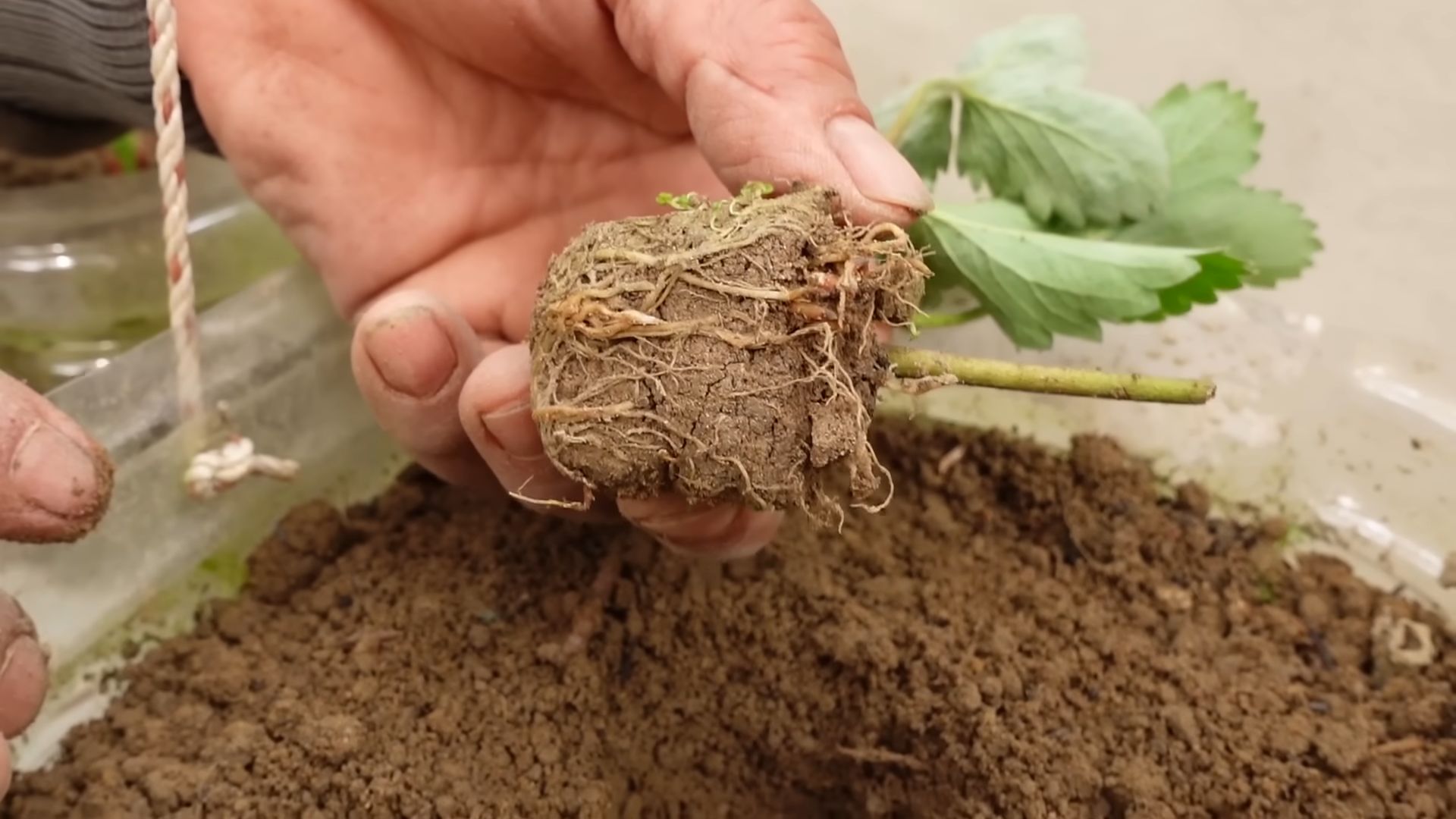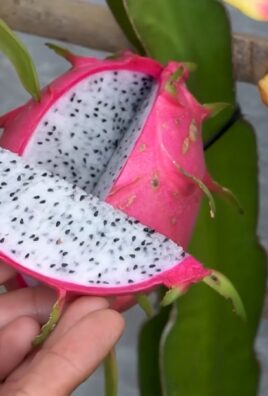Grow Strawberries at Home, and unlock a world of sweet, juicy goodness right in your backyard! Imagine plucking sun-ripened strawberries, bursting with flavor, just steps from your kitchen. Forget the bland, store-bought berries – with a few simple tricks and a little DIY magic, you can cultivate your own thriving strawberry patch, no matter the size of your space.
Strawberries have a rich history, dating back to ancient Rome, where they were prized for their medicinal properties. Over centuries, they’ve become a symbol of love, sweetness, and summer. But beyond their delicious taste and cultural significance, growing your own strawberries offers a unique connection to nature and a rewarding sense of accomplishment.
Why should you embark on this DIY adventure? Well, for starters, you’ll have access to the freshest, most flavorful strawberries imaginable. Plus, you’ll know exactly what’s going into your food – no harmful pesticides or chemicals. And let’s be honest, there’s something incredibly satisfying about nurturing a plant from seedling to harvest. I’m going to share some easy-to-follow tips and tricks that will help you grow strawberries at home successfully, even if you’re a complete beginner. Get ready to transform your garden (or balcony!) into a strawberry paradise!

Grow Your Own Delicious Strawberries: A DIY Guide
Hey there, fellow gardening enthusiasts! I’m so excited to share my tried-and-true method for growing plump, juicy strawberries right at home. Forget those bland, store-bought berries – nothing beats the taste of homegrown goodness. This guide will walk you through everything you need to know, from choosing the right variety to harvesting your sweet rewards. Let’s get started!
Choosing the Right Strawberry Variety
Before you even think about planting, you need to decide which type of strawberry is best for you. There are three main types:
* June-Bearing: These produce one large crop of strawberries, usually in late spring or early summer (hence the name!). They’re great if you want a big batch for jam-making or freezing.
* Everbearing: Don’t let the name fool you – they don’t produce berries constantly. Instead, they give you two or three harvests throughout the growing season: one in spring, one in late summer/early fall.
* Day-Neutral: These are the most consistent producers, offering a steady supply of strawberries throughout the growing season as long as the temperature is between 35-85 degrees.
Consider your climate, available space, and how you plan to use your strawberries when making your choice. I personally love day-neutral varieties because I enjoy having fresh berries all summer long.
Preparing Your Strawberry Patch
Strawberries need a sunny spot with well-draining soil. Aim for at least 6-8 hours of direct sunlight per day.
* Soil Testing: Before planting, it’s a good idea to test your soil’s pH. Strawberries thrive in slightly acidic soil, with a pH between 5.5 and 6.8. You can buy a soil testing kit at most garden centers.
* Soil Amendment: Amend your soil with plenty of organic matter, such as compost or well-rotted manure. This will improve drainage, fertility, and water retention. I usually add a generous layer of compost a few weeks before planting.
* Weed Removal: Strawberries don’t like competition, so make sure to remove all weeds from your planting area. You can use a hoe or hand-pull them. I also like to lay down a layer of landscape fabric to prevent weeds from coming back.
Planting Your Strawberry Plants
Now for the fun part – planting! You can buy strawberry plants as bare-root plants or as potted plants. Bare-root plants are usually cheaper, but they require a little more care.
* Spacing: Space your strawberry plants about 12-18 inches apart in rows that are 3-4 feet apart. This will give them plenty of room to grow and spread.
* Planting Depth: When planting, make sure the crown of the plant (where the roots meet the stem) is level with the soil surface. Don’t bury the crown, or it will rot.
* Watering: Water your newly planted strawberries thoroughly. Keep the soil consistently moist, but not soggy, until the plants are established.
Step-by-Step Planting Instructions:
1. Prepare the Planting Hole: Dig a hole that is wide and deep enough to accommodate the roots of your strawberry plant.
2. Loosen the Roots: Gently loosen the roots of the plant before placing it in the hole. This will encourage them to spread out and establish themselves.
3. Position the Plant: Place the plant in the hole, making sure the crown is level with the soil surface.
4. Backfill with Soil: Fill the hole with soil, gently firming it around the plant.
5. Water Thoroughly: Water the plant thoroughly to settle the soil and provide moisture.
6. Mulch (Optional): Add a layer of mulch around the plants to help retain moisture, suppress weeds, and keep the berries clean. Straw is a classic choice for mulching strawberries.
Caring for Your Strawberry Plants
Once your strawberries are planted, it’s important to provide them with the care they need to thrive.
* Watering: Water your strawberry plants regularly, especially during dry spells. Aim for about 1 inch of water per week. Avoid overhead watering, as this can promote fungal diseases. Drip irrigation is a great option.
* Fertilizing: Fertilize your strawberry plants in early spring and again after the first harvest. Use a balanced fertilizer that is specifically formulated for berries. I like to use a slow-release fertilizer.
* Weed Control: Keep your strawberry patch free of weeds. Hand-pull any weeds that pop up, or use a hoe to cultivate the soil.
* Pest and Disease Control: Keep an eye out for pests and diseases. Common strawberry pests include slugs, snails, and aphids. Common diseases include gray mold and leaf spot. Treat any problems promptly with appropriate organic or chemical controls. I prefer using organic methods whenever possible.
* Runner Management: June-bearing strawberries produce runners, which are long stems that grow out from the main plant. These runners will root and form new plants. If you want to maximize your berry production, it’s best to remove the runners. However, if you want to expand your strawberry patch, you can allow the runners to root. Everbearing and day-neutral varieties produce fewer runners.
Protecting Your Strawberries
Birds and other critters love strawberries just as much as we do! Here are a few ways to protect your precious berries:
* Netting: Cover your strawberry plants with netting to keep birds away. Make sure the netting is securely anchored to the ground so that birds can’t get underneath it.
* Row Covers: Use row covers to protect your strawberries from frost, pests, and diseases. Row covers are lightweight fabric covers that you can place over your plants.
* Scarecrows: A scarecrow can help deter birds and other animals from your strawberry patch.
* Companion Planting: Plant herbs like basil, thyme, and rosemary near your strawberries to repel pests.
Harvesting Your Strawberries
The moment you’ve been waiting for – harvesting your delicious strawberries!
* When to Harvest: Strawberries are ready to harvest when they are fully red and slightly soft to the touch. They should also detach easily from the plant.
* How to Harvest: Gently twist or cut the strawberry from the plant, leaving a small piece of the stem attached.
* Storage: Store your freshly harvested strawberries in the refrigerator. They will last for about a week.
Step-by-Step Harvesting Instructions:
1. Check for Ripeness: Look for strawberries that are fully red, plump, and slightly soft.
2. Gently Grasp the Berry: Hold the strawberry gently between your thumb and forefinger.
3. Twist and Pull: Twist the berry slightly and gently pull it away from the plant. It should detach easily.
4. Leave the Cap On: Leave the green cap (calyx) attached to the berry. This will help it stay fresh longer.
5. Place in a Container: Place the harvested strawberries in a shallow container to avoid bruising.
6. Refrigerate Promptly: Refrigerate the strawberries as soon as possible to maintain their freshness.
Troubleshooting Common Strawberry Problems
Even with the best care, you may encounter some problems when growing strawberries. Here are a few common issues and how to address them:
* Small Berries: Small berries can be caused by a lack of water, nutrients, or sunlight. Make sure your plants are getting enough of all three.
* Rotting Berries: Rotting berries can be caused by fungal diseases, such as gray mold. Improve air circulation around your plants and avoid overhead watering.
* Pest Infestations: Pests can damage your strawberry plants and reduce your yield. Identify the pest and treat it with appropriate organic or chemical controls.
* Lack of Fruit: A lack of fruit can be caused by a variety of factors, including poor pollination, frost damage, or nutrient deficiencies. Make sure your plants are getting enough sunlight, water, and nutrients. You can also try hand-pollinating the flowers.
Extending Your Strawberry Season
Want to enjoy fresh strawberries for even longer? Here are a few tips for extending your strawberry season:
* Choose Different Varieties: Plant a combination of June-bearing, everbearing, and day-neutral varieties to spread out your harvest.
* Use Row Covers: Row covers can protect your plants from frost and extend the growing season.
* Plant in Containers: Planting strawberries in containers allows you to move them indoors or to a sheltered location during cold weather.
* Succession Planting: Plant new strawberry plants every few weeks to ensure a continuous supply of berries.
Propagating Strawberries
Once you have a thriving strawberry patch, you can easily propagate new plants from runners.
* Allow Runners to Root: Allow the runners from your strawberry plants to root in the soil.
*

Conclusion
So, there you have it! Transforming your outdoor space into a thriving strawberry patch is not only achievable but incredibly rewarding. We’ve walked you through the simple yet effective steps to successfully cultivate your own delicious, juicy strawberries right at home. Forget those bland, store-bought berries – imagine the burst of flavor from a sun-ripened strawberry, picked fresh from your own garden.
This DIY approach to growing strawberries offers a multitude of benefits. Firstly, you have complete control over the growing process, ensuring your berries are free from harmful pesticides and chemicals. Secondly, it’s a fantastic way to connect with nature and enjoy the therapeutic benefits of gardening. And thirdly, let’s be honest, there’s a certain satisfaction that comes from nurturing something from a tiny seedling to a bountiful harvest.
But the journey doesn’t end here! Feel free to experiment with different strawberry varieties to discover your personal favorites. Consider adding companion plants like basil or marigolds to deter pests and enhance the flavor of your strawberries. You can also explore different growing methods, such as vertical gardening or hanging baskets, to maximize space and add visual appeal to your garden. For those with limited space, container gardening is an excellent option, allowing you to enjoy fresh strawberries even on a small balcony or patio.
Don’t be afraid to get creative and personalize your strawberry-growing experience. Perhaps you’ll discover a unique fertilizer blend that yields exceptionally sweet berries, or maybe you’ll develop a clever watering system that conserves water and promotes healthy growth. The possibilities are endless!
Ultimately, the key to success lies in patience, observation, and a willingness to learn. Pay close attention to your plants, monitor their growth, and adjust your care routine as needed. Remember that growing strawberries is a continuous learning process, and every season brings new opportunities to refine your skills and improve your harvest.
We are confident that with a little effort and dedication, you’ll be enjoying a steady supply of delicious, homegrown strawberries in no time. So, grab your gardening gloves, gather your supplies, and embark on this exciting adventure. We encourage you to try this DIY trick and experience the joy of growing your own food.
And most importantly, we want to hear about your experiences! Share your tips, tricks, and triumphs in the comments below. Let us know what strawberry varieties you’re growing, what challenges you’ve encountered, and what successes you’ve celebrated. Together, we can create a vibrant community of strawberry enthusiasts, sharing our knowledge and inspiring others to embrace the joys of homegrown produce. Let’s all learn how to grow strawberries at home together!
Frequently Asked Questions (FAQ)
What is the best time of year to plant strawberries?
The ideal time to plant strawberries depends on your climate and the type of strawberry you’re growing. Generally, early spring or late fall are the best times. In warmer climates, fall planting allows the plants to establish roots before the heat of summer. In colder climates, spring planting gives the plants a head start before winter arrives. June-bearing strawberries are typically planted in early spring, while everbearing and day-neutral varieties can be planted in either spring or fall. Always check the specific recommendations for the variety you choose.
What kind of soil is best for growing strawberries?
Strawberries thrive in well-drained, slightly acidic soil with a pH between 5.5 and 6.5. The soil should be rich in organic matter to provide essential nutrients and retain moisture. Before planting, amend the soil with compost, well-rotted manure, or other organic amendments to improve its fertility and drainage. Avoid heavy clay soils, as they can become waterlogged and lead to root rot. If you have clay soil, consider growing strawberries in raised beds or containers with a specially formulated potting mix.
How much sunlight do strawberries need?
Strawberries require at least six to eight hours of direct sunlight per day to produce a bountiful harvest. Choose a planting location that receives ample sunlight throughout the day. If you live in a hot climate, some afternoon shade may be beneficial to prevent the plants from overheating. Insufficient sunlight can result in smaller berries and reduced yields.
How often should I water my strawberry plants?
Water your strawberry plants regularly, especially during dry periods. The soil should be consistently moist but not waterlogged. Water deeply and less frequently, rather than shallowly and more often, to encourage deep root growth. Avoid overhead watering, as it can promote fungal diseases. Use a soaker hose or drip irrigation system to deliver water directly to the roots. During hot weather, you may need to water your plants more frequently.
What are some common pests and diseases that affect strawberries?
Strawberries are susceptible to a variety of pests and diseases, including aphids, spider mites, slugs, snails, gray mold, and leaf spot. Regularly inspect your plants for signs of infestation or disease. Remove any affected leaves or berries promptly. Use organic pest control methods, such as insecticidal soap or neem oil, to control pests. Ensure good air circulation around your plants to prevent fungal diseases. Consider using disease-resistant strawberry varieties.
How do I fertilize my strawberry plants?
Fertilize your strawberry plants in early spring and again after the first harvest. Use a balanced fertilizer specifically formulated for berries. Follow the instructions on the fertilizer package carefully. Avoid over-fertilizing, as it can lead to excessive foliage growth and reduced fruit production. You can also amend the soil with compost or other organic matter to provide a slow-release source of nutrients.
How do I protect my strawberries from birds and other animals?
Birds and other animals, such as squirrels and rabbits, can be a major nuisance when growing strawberries. To protect your berries, cover your plants with netting or row covers. You can also use bird netting or scarecrows to deter birds. Consider planting strawberries in a fenced-in area to keep out larger animals.
How do I overwinter my strawberry plants?
In colder climates, strawberry plants need protection during the winter months. After the first frost, mulch your plants with straw, pine needles, or shredded leaves to insulate the roots and protect them from freezing temperatures. Remove the mulch in early spring when new growth begins to emerge. In warmer climates, you may not need to mulch your plants, but you should still protect them from frost if temperatures are expected to drop below freezing.
How long does it take for strawberry plants to produce fruit?
The time it takes for strawberry plants to produce fruit depends on the variety and the growing conditions. June-bearing strawberries typically produce fruit in their second year, while everbearing and day-neutral varieties can produce fruit in their first year. However, it’s best to remove the blossoms from everbearing and day-neutral varieties in their first year to encourage stronger root growth and a larger harvest in subsequent years.
Can I grow strawberries in containers?
Yes, strawberries can be successfully grown in containers. Choose a container that is at least 12 inches deep and wide. Use a well-draining potting mix and ensure the container has drainage holes. Water regularly and fertilize as needed. Container-grown strawberries may require more frequent watering and fertilization than those grown in the ground. Consider using hanging baskets or vertical planters to maximize space and add visual appeal.





Leave a Comment